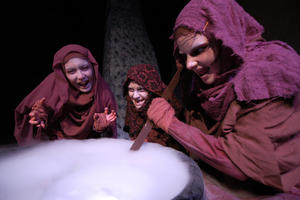I recently read C.L. Moore’s Judgement Night (review here), and it got me thinking.
Moore was writing in the pulp era, very successfully. She and her husband Henry Kuttner (whose first contact with her was a fan letter he wrote, believing she was a man) often collaborated on their stories, but in the interests of not disappearing down a pointless rabbit-hole I’m going to assume that the stories with her name on were primarily her work.
Moore’s stories, while definitely in the pulp mould, had extra elements that lifted them out of the ordinary. Her Wikipedia entry notes her use of the senses and emotions, but I’m going to talk about something else she did, which I refer to as “telling two stories at once”.
External and Internal Stories
Drastic oversimplification time: one of the key differences between “genre” fiction and “literary” fiction is often that “genre” fiction has a lot going on externally (events that you’d see on a movie screen), whereas “literary” fiction has a lot going on internally to the characters (thoughts, emotions, internal dialogue, reflections on the meaning of life). This makes it unsurprising that most of the top-grossing movies of all time have been “genre” movies: science fiction, fantasy or thrillers, primarily.
There’s absolutely nothing wrong with this. Sometimes, I’m in the mood for a story that doesn’t attempt to do anything more than entertain me with the external events. As a matter of taste, I’m personally seldom if ever in the mood for a story that has very few events but a lot of internal reflection. What I really like a lot, though, is when someone manages to pull off both at once, which is what Moore did in many of her stories.
Most of the stories we recognise as “classic literature” do this. Shakespeare has murder and walking spirits and Birnam Wood coming to Dunsinane, but he also has “Tomorrow and tomorrow and tomorrow” and “Out, damned spot!” Dickens, Jane Austen, Mark Twain, most of the authors whose names everyone recognises tell two stories at once: the story of the outward events, and the story of the significance of those events.
By the significance of the events I don’t just mean their significance to the characters, though that is how we encounter it, through the characters’ eyes. The authors who are best at this manage to make the characters’ thoughts, reactions and emotions point beyond them to something more universal about being human.
For example, the story “Judgement Night” in the collection of the same name is about the fall of a galactic empire. However, it’s also about the heir to that empire, and her close brush with a love affair, and how her training as an amazon warrior makes her reject the emotional and relational side of life, and how that influences the empire’s fall. And that, in turn, is about masculinity and femininity, relationship and connection, competition and conflict, love and death. It’s all woven together. If you told just the story of the fall of the empire, it would work as a story by itself, but it wouldn’t have the richness and depth of the story that Moore does tell.
How I’m Applying This
If I look at someone else’s craft, it’s at least partly to improve my own (that’s a big part of why I write reviews).
There’s a writing concept called “scene and sequel” that Jim Butcher describes very well. In this context, a “scene” is what I’ve been calling the outward story: some things happen. A “sequel” is where the characters reflect on it and make it part of their internal stories (and hopefully the greater, more universal story).
My first Gryphon Clerks book, Realmgolds, has lost some readers because they felt that I didn’t do enough of the internal story sometimes. Other readers don’t seem bothered by it; perhaps it’s just that they’re already enough like the characters (and me) that they get what I was going for without my spelling it out, that they naturally understand how a character like that would feel. However, if I’m to improve as a writer and satisfy more readers, I need to take that criticism on.
When I was writing Hope and the Clever Man, I had a scene in it where two of the characters get caught up in a riot. Bearing in mind the lessons I’d learned, I added a couple of sentences of sequel to the end of it, in which the characters said something like, “I’ve never been so frightened in my life!” “Me either.”
Starting to deepen your stories can be that simple: taking a moment to show the reader what the events the character has just experienced mean to them.
Mike Reeves-McMillan lives in Auckland, New Zealand, the setting of his Auckland Allies contemporary urban fantasy series; and also in his head, where the weather is more reliable, and there are a lot more wizards. He also writes the Gryphon Clerks series (steampunk/magepunk), the Hand of the Trickster series (sword-and-sorcery heist capers), and short stories which have appeared in venues such as Compelling Science Fiction and Cosmic Roots and Eldritch Shores.


Leave a Reply
You must be logged in to post a comment.